Understanding Sonar
Sonar plays an invaluable role on your boat to let you 'see' beneath the water's surface. The term 'sonar' is an acronym for 'SOund NAvigation and Ranging'. It can be considered a close cousin of radar, but one that uses technologies that detects targets in the water rather than the air. Marine electronics utilising this technology have various names, including depth or echo sounders, fishfinders and forward-looking sonar.
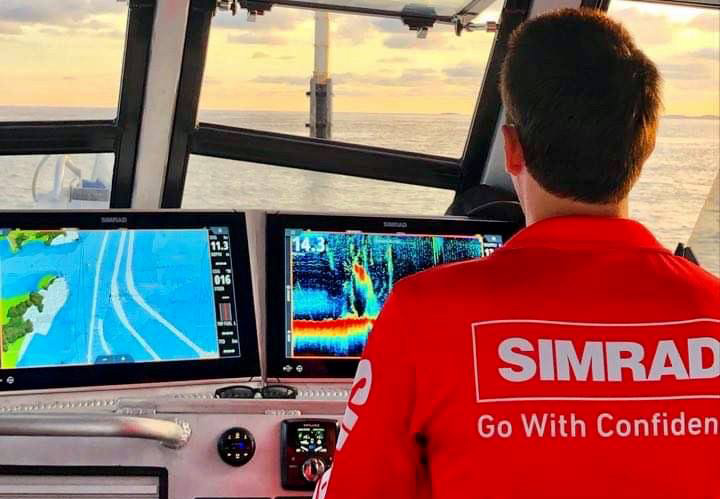
How sonar works
There are two types of sonar – passive and active.
Many first become aware of sonar through classic submarine films like The Hunt for Red October. Have you seen a headphone-wearing operator on a ship or submarine listening for the sounds of an approaching vessel, assisted by the excellent transmissibility of sound in water? This is called passive sonar. It is a one-way technology where you rely on the target transmitting sound for its detection.
The technology you will encounter on leisure boats is called active sonar. It uses transmitted sound signals to detect fish and underwater terrain by measuring the time it takes for echoes to reflect from them.
Sound travels through water at around 1480 metres per second, more than four times the speed of sound in air, so those echoes arrive back at your boat very quickly. The time taken for resultant echoes to return provides the necessary data on the distance to the target. Sophisticated sonar also detects more detail, such as the likely hardness of the material in terrain and the size and number of fish.
Turning to the movies again, the way you will have seen active sonar portrayed is the repetitive sound of a slow audible ping sent out to detect a submarine, which was how vessel detection worked around 80 years ago. For a leisure boat in the 21st Century, the sound waves that your sonar sends happen thousands of times per second. For most applications, there is no noise of any kind detectable by the human ear or by fish as the signals lie in the ultrasonic range.
How can I utilise sonar on my boat, and why?
Sonar is a collective term used for equipment which allows you to detect underwater terrain and fish in the water. When you want to put it to practical use, you will find this technology in the following types of marine electronics.
Depth sounders or echo sounders
Instruments to display the vertical distance between your boat and the sea or river bed as a numeric value. Depth data is typically shared across integrated networks, allowing you to display the depth beneath your craft as a number and often also a rising or falling trend, wherever you need it.
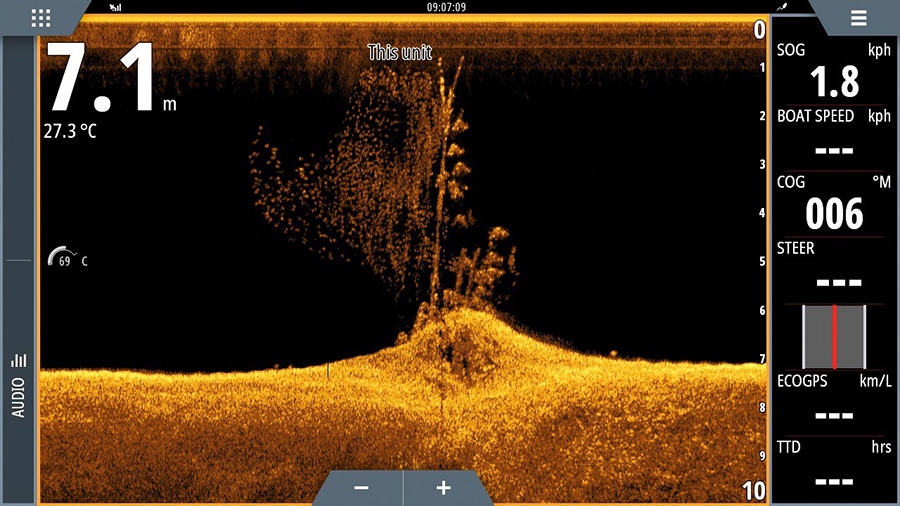
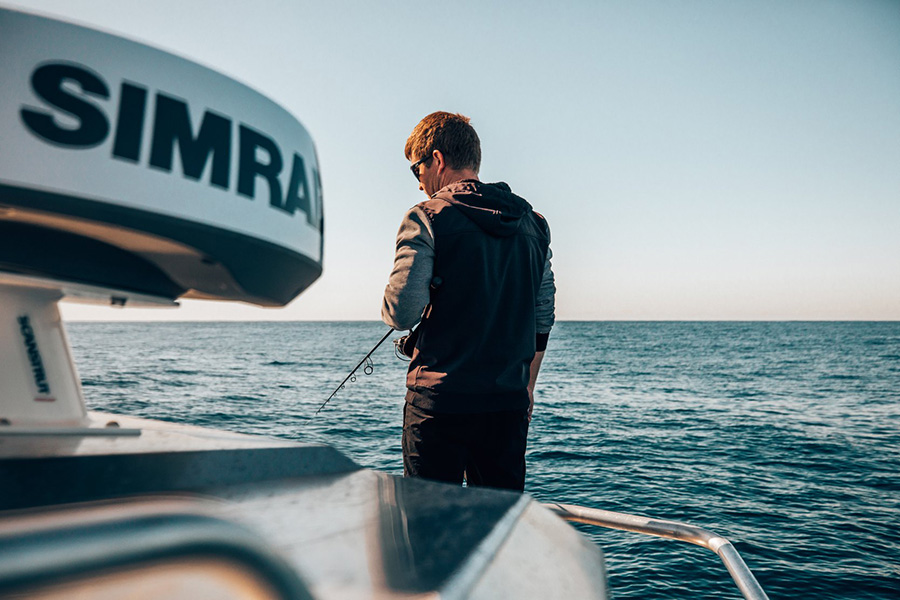
You can set customisable alarms, so you are alerted if the depth is becoming too shallow. This is useful when moving but also at anchor if in tidal waters. Fine-tuning options include the ability to 'offset' the reading – adjusting for the difference between your boat's waterline and the transducer's location (see below) to get a depth reading related to expected charted values.
Depth sounder capability is essential for almost any boat, from small tenders to superyachts. However, the technology has been affordable for a long time, and some units on older craft won't be working well, so it is always worth considering an upgrade.
Fishfinders
Fishfinders offer everything a depth sounder does, but add a detailed colour-coded picture in two or three dimensions of everything underneath and to the sides of your boat, either on a standalone instrument or Multifunction Display (MFD). This provides a clear image of underwater terrain, anything suspended or swimming beneath the boat and even temperature gradients in the water.
Fish finders have an obvious purpose for those who catch fish for pleasure or work or for those wishing to research and understand our rich world under the surface. However, the level of automation in modern Simrad® fishfinders and the clarity of the picture can add a lot to your day to appreciate the world underneath your boat.
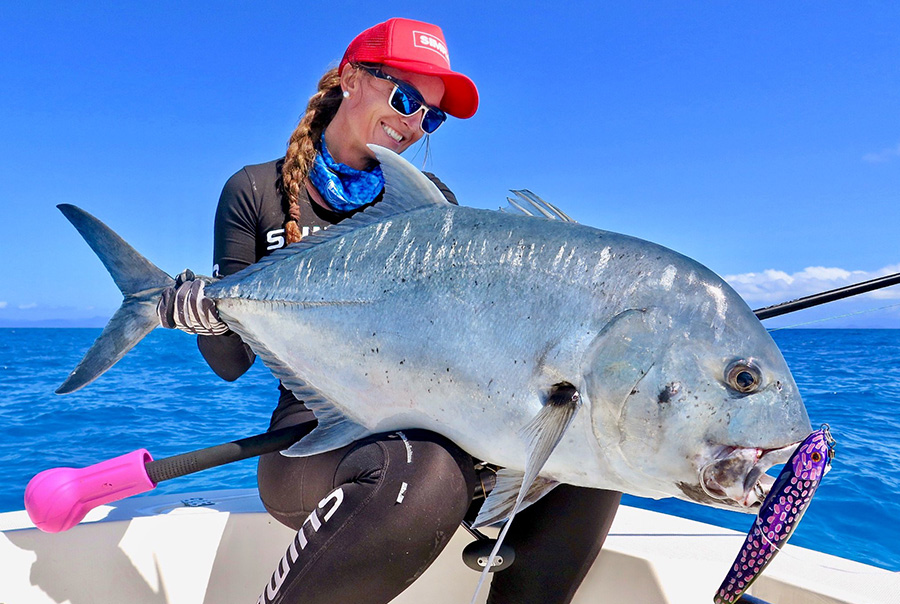
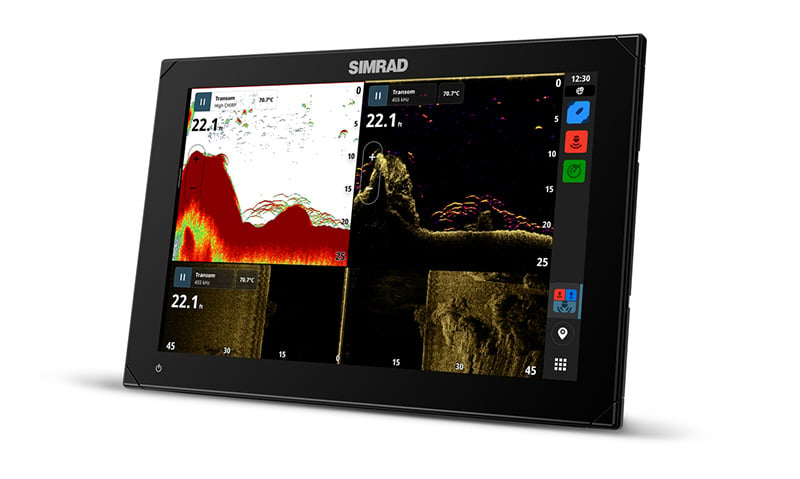
As the name suggests, fishfinders have been developed predominantly to take much guesswork out locating your preferred catch of the day. The sophisticated images of what lies beneath provided by expensive commercial fishing boat electronics are now highly accessible to small boat anglers and – as we will see further into this article, not just immediately underneath the boat but also to its sides.
Fishfinders are not just for anglers, however. Even at the most basic level, a fishfinder can help keep all aboard engaged with the promise. They aid normal boat navigation with a rolling real-time view of underwater terrain and a graphic alert of a rising sea floor or river bed. For those who like diving and snorkelling, you can build a picture of what you expect to encounter before getting wet.
ForwardScan or forward-looking sonar
This is a specialist type of sonar that sends sound signals ahead of the boat to provide a picture of the underwater terrain you are approaching. The resultant data is shown as a detailed colour-coded picture on a compatible MFD.
This kind of technology offers safety benefits for any boat. It is particularly appealing for those who like to explore out-of-the-way bays, inlets and river courses, where charted information may not exist or be based on old or poor surveys.
You can read more about the wide range of available Simrad® sonar options here.
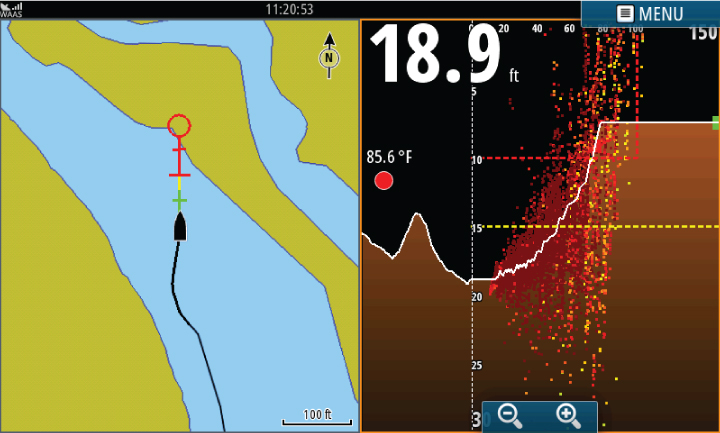
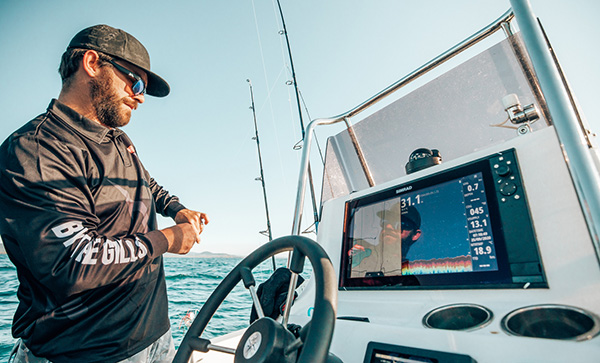
The transducer
Whatever type of sonar system you wish to use, there is a common component you will require called the transducer. It acts like a powerful combined underwater loudspeaker and sensitive microphone. It simultaneously pulses sonar signals into the water and listens for echoes that bounce back from the seabed and other submerged targets. To visualise this, imagine shouting in a tunnel and then waiting to hear the echo of your voice return.
Simrad Yachting offers an extensive range of depth and sonar transducers to cover all requirements, from primary depth sounder data to three-dimensional images.
For fish finding applications, dual range and dual frequency transducers are typical. Lower frequencies (50kHz or 50,000 sound pulses per second) are used for deeper water across a wider area. Higher frequencies (200kHz or 200,000 sound pulses per second) better define targets in a narrower beam.
CHIRP
The use of different frequencies to improve performance has been improved by CHIRP (Compressed High-Intensity Radar Pulse) transducers. This clever technology employs a precise sweep pattern of many frequencies within a long-duration transmit pulse from a broadband sonar transducer. The equivalent sound energy transmitted into the water is many times greater than a conventional marine fishfinder, and the image's resolution is much higher.
CHIRP provides incredible extra detail, with clear resolution of often complex objects in a way that was impossible before.
Read a more detailed explanation of CHIRP sonar and its benefits here.
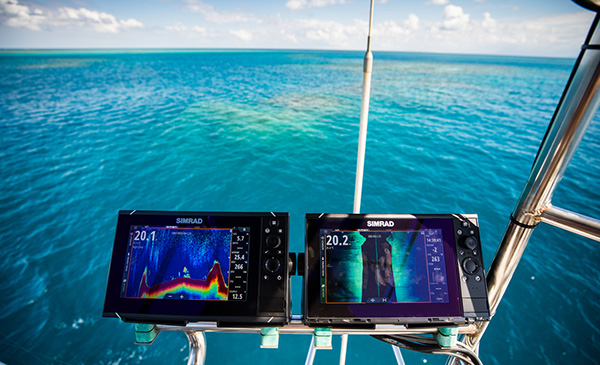
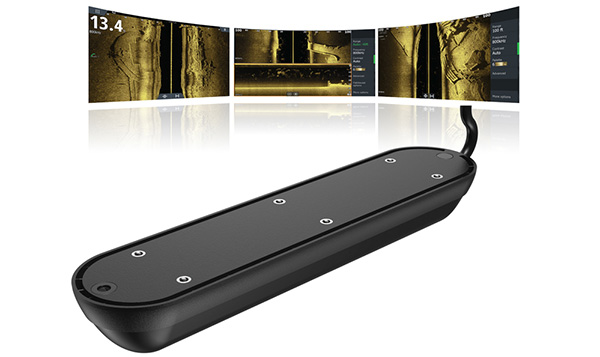
Even greater resolution
Simrad Yachting has continued to build on CHIRP and other technologies to improve the definition of what you can detect beneath the waves.
Active Imaging™ is the latest development for our mainstream transducers that adds even greater definition when looking for fish and their holding areas. The Active Imaging 3-In-1 transducer provides SideScan, DownScan Imaging™ and a medium-high (83/200Khz) CHIRP sonar. This enables the pinpointing of fish-holding areas like rockpiles, standing timber, weed beds, ditches and drop-offs.
For the ultimate ability to adjust where you look without moving the boat, Simrad® offers StructureScan® 3D, which builds a three-dimensional model of the world between your feet and lets you virtually pan and tilt towards points of interest.
Another up-and-coming product compatible with the latest Simrad® MFDs is ActiveTarget®. This technology uses multiple sound waves from an incredible 420 separate elements, all combined in one transducer. ActiveTarget® produces incredible detail, revealing individual fish and how they react to bait in real-time. You can select three views – down, forward or scout – the latter gives a broader forward view to detect which way to direct the boat.
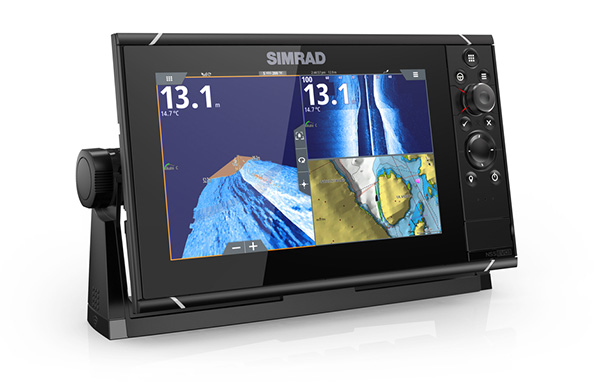
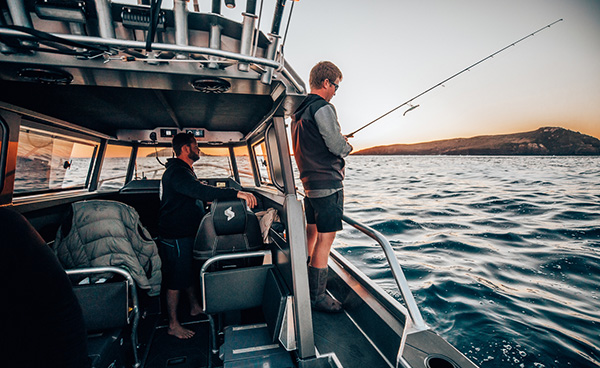
Choice of transducer type
You'll typically be guided in your choice of the transducer by the capabilities you require and the depth instrument, fishfinder or MFD on which you want to display the information.
You also need to consider the installation of your transducer and the most appropriate of several choices to suit all applications. To function correctly, a transducer must be:
- in direct water contact or connected acoustically to the water
- aligned correctly for its intended use
- clean and not overcoated with paint or heavily fouled
- in a place where the water flow is as smooth as possible when your boat is moving with minimal air bubbles in the water flow
Fortunately, there are transducer types to match just about every requirement you might have. Many involve making a dedicated hole in the boat, so that is a job you would typically plan for a maintenance period ashore and with someone competent to ensure a water-tight installation. Smaller trailable craft often utilise transom-mounted transducers.
Read more about ways of mounting sonar transducers here.
To avoid any adverse reaction between the hull and transducer housing when immersed, it's also essential to pick the correct match of material.
- FRP (Fibre-reinforced plastic) hulls should use plastic transducer housings.
- Steel or aluminium hulls should be fitted with plastic or stainless steel transducer housings.
- Wooden hulls should be equipped with bronze transducer housings.
For the best advice on choosing a transducer, your local Simrad® dealer will be pleased to assist.
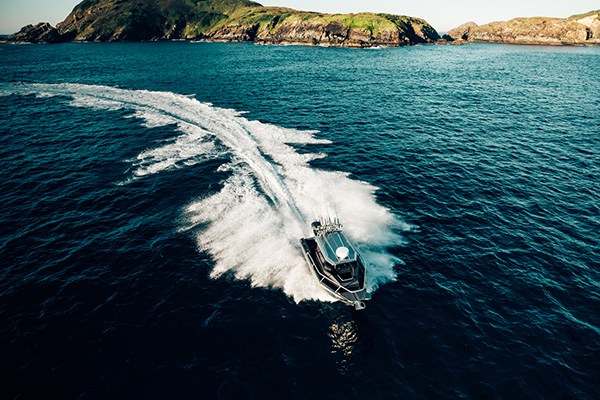
What else do I need?
To operate, transducers need to be connected directly to a compatible MFD, standalone display, hub or black box.
If you have an integrated system on your boat, the transducer's connected unit will typically share primary depth data around a compatible network.
Within Simrad Yachting’s family of products, you can also create multi-station fishfinding displays and share other rich sonar data to view the information, where you need it.
The starting point is to define the level of detail and performance you would like to see from your choices, then plan a system from there. Again, get in touch with your local Simrad® marine electronics dealer, who can advise on the best ideas for any given boat size, type and purpose.
Choice of transducer type
You'll typically be guided in your choice of the transducer by the capabilities you require and the depth instrument, fishfinder or MFD on which you want to display the information.
You also need to consider the installation of your transducer and the most appropriate of several choices to suit all applications. To function correctly, a transducer must be:
- in direct water contact or connected acoustically to the water
- aligned correctly for its intended use
- clean and not overcoated with paint or heavily fouled
- in a place where the water flow is as smooth as possible when your boat is moving with minimal air bubbles in the water flow
Fortunately, there are transducer types to match just about every requirement you might have. Many involve making a dedicated hole in the boat, so that is a job you would typically plan for a maintenance period ashore and with someone competent to ensure a water-tight installation. Smaller trailable craft often utilise transom-mounted transducers.
Read more about ways of mounting sonar transducers here.
















